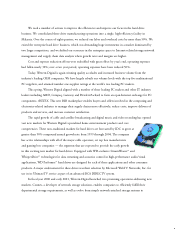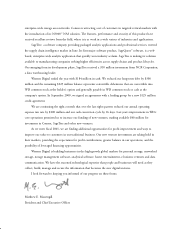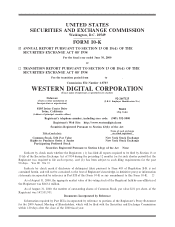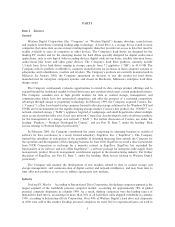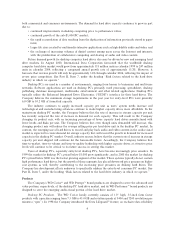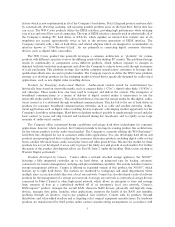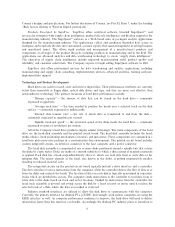Western Digital 2000 Annual Report Download - page 14
Download and view the complete annual report
Please find page 14 of the 2000 Western Digital annual report below. You can navigate through the pages in the report by either clicking on the pages listed below, or by using the keyword search tool below to find specific information within the annual report.5%, 6%, and 5% of revenue for 1998, 1999, and 2000, respectively. The Company's current retail customer
base is in the United States and Canada. The retail channel complements the Company's other sales channels
while helping to build brand awareness for the Company and its products. Retailers supply the aftermarket
""upgrade'' sector in which end-users purchase and install products to upgrade their computers. The Company
grants certain of its retailers price protection and limited rights to return product on a rotation basis. The
Company also sells its retail-packaged products through the Internet, at its Web Site,
http://www.westerndigital.com.
The Company maintains sales oÇces throughout North America, Eastern and Western Europe, the
Middle East, Japan and Southeast Asia. Field application engineering is provided to strategic computer
manufacturer accounts, and end-user technical support services are provided within the United States and
Europe. The Company's end-user technical support is supplied by both employees and qualiÑed third-party
support organizations through telephone support during business hours and via the Company's web site.
The Company's international sales, which include sales to foreign subsidiaries of U.S. companies,
represented 43%, 45%, and 53% of revenues for Ñscal years 1998, 1999 and 2000, respectively. Sales to
international customers may be subject to certain risks not normally encountered in domestic operations,
including exposure to tariÅs, various trade regulations and Öuctuations in currency exchange rates. See Part II,
Item 7, under the heading ""Risk factors relating to Western Digital particularly.''
For information concerning revenue recognition, sales by geographic region and signiÑcant customer
information, see Notes 1 and 7, respectively, of Notes to Consolidated Financial Statements.
The Company's marketing and advertising functions are performed both internally and through outside
Ñrms. Advertising, direct marketing, worldwide packaging and marketing materials are targeted to various
end-user segments. Western Digital utilizes both consumer media and trade publications. The Company has
programs under which qualifying manufacturers and resellers are reimbursed for certain advertising expendi-
tures. Western Digital also invests in direct marketing and customer satisfaction programs. The Company
maintains ongoing contact with end users through primary and secondary market research, focus groups,
product registrations and technical support databases.
Competition
In the desktop product market, the Company competes primarily with Fujitsu, IBM, Maxtor, Quantum,
Samsung and Seagate.
The hard drive industry is intensely competitive, with hard drive suppliers competing for a limited
number of major customers. Hard drives manufactured by diÅerent competitors are highly substitutable due
to the industry mandate of technical form, Ñt and function standards. Hard drive manufacturers compete on
the basis of product quality and reliability, storage capacity, unit price, product performance, production
volume capabilities, delivery capability, leadership in time-to-market, time-to-volume and time-to-quality and
ease of doing business. The relative importance of these factors varies among diÅerent customer and market
segments. The Company believes that it is generally competitive in all of these factors.
The Company believes that it cannot diÅerentiate its hard drive products solely on attributes such as
storage capacity; therefore, the Company also diÅerentiates itself by designing and incorporating into its hard
drives desirable product performance attributes and by emphasizing rapid response with its computer
manufacturer and distribution customers and brand equity with its end users. These product performance
attributes include seek time, data transfer rates, intelligent caching, failure prediction, remote diagnostics,
acoustics and data recovery. Rapid response requires accelerated design cycles, customer delivery and
production Öexibility, which contribute to customer satisfaction. Data storage has become strategically critical
for computer end users. Consequently, the Company believes that trust in a manufacturer's reputation has
become an important factor in the selection of a hard drive, particularly within such a rapidly changing
technology environment. The Company believes it has strong brand equity with its end users.
The Company's market share eroded in 1998, primarily due to competitive conditions in the hard drive
industry (with resulting cutbacks in production), the timing of the Company's transition from thin Ñlm to
9


